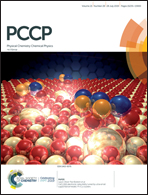A comprehensive insight on H-type aggregation in Congo red-surfactant systems revealed through spectroscopic and electrochemical study unified with a simulation framework
Abstract
Interaction of an anionic diazo dye, Congo red (CR), with conventional surfactants: cetyltrimethylammonium bromide (CTAB) and Gemini surfactant: N,N′-dihexadecyl-N,N,N′,N′-tetramethyl-N,N′-ethanediyl-diammonium dibromide (16-2-16), in their pre-micellar and post-micellar concentration regions has been investigated using conductometry, surface tensiometry, UV-visible spectroscopy, fluorescence spectroscopy, dynamic light scattering (DLS), cyclic voltammetry (CV) and linear sweep voltammetry (LSV) techniques. Various interfacial, micellar, band gap and electrochemical parameters are estimated at 303.15 K. The observed results are explained in terms of critical micelle concentration (CMC) of the individual surfactants and their ability to undergo aggregation in the presence of dianionic CR. It is found that the CMC of both the surfactants decreases in the presence of CR, which is attributed to the electrostatic attraction, short-range π–π stacking of CR molecules, and the hydrophobic forces operating between CR and the surfactant molecules. The spectral results for CR showed a hypsochromic (blue) shift below the CMC for both the surfactants, which indicates the resultant CR–surfactant complexation through ion-pair formation, which further inferred H-aggregation of CR in the pre-micellar region. Above the CMC, CR reverts back to its monomeric state and gets bound to the micelle. Job's method is employed to determine the stoichiometric ratio between CR and the individual surfactant. The size distribution of surfactants in the presence of CR is determined by DLS. The CV and LSV measurements were performed in the absence and presence of a varying concentration of surfactants to support the spectral findings. Diffusion coefficient (D) calculated by LSV confirmed the successive interaction between CR and surfactants. Furthermore, the CR–surfactant interaction is also elucidated by the computational simulation using the Gauss View 5.0.9 package to validate the obtained experimental findings.



 Please wait while we load your content...
Please wait while we load your content...